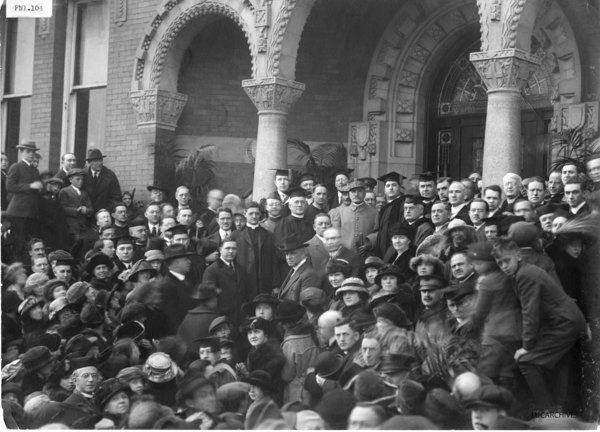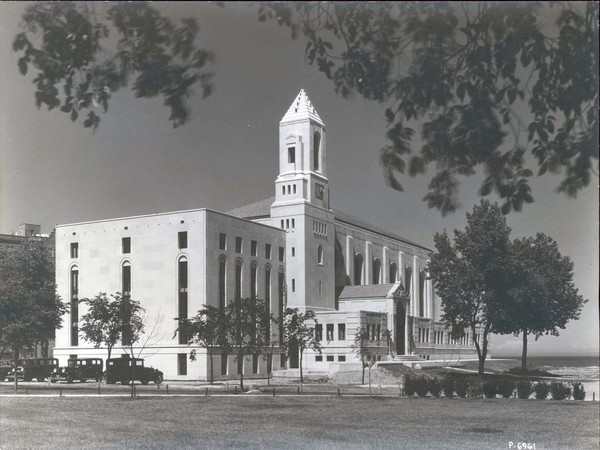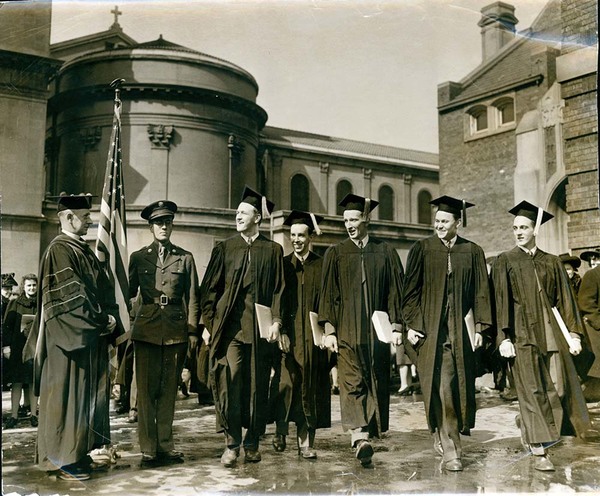A Period of Transition: 1920-1945
The "Roaring Twenties" saw 2,000 students at Loyola University. This was the era of the "flapper," the "Charleston," and the 10-cent package of cigarettes, the nickel cigar, and prohibition. Although the horse still remained a prime means of transportation, he was being replaced by the automobile and America was caught up in the popularity of the radio.
In 1921, Marshal Ferdinand Foch, commander-in-chief of the Allied Forces during World War I, visited Loyola and was awarded an honorary LL.B. degree.
In 1922, Loyola founded a Correspondence Study Division, and established a School of Business Administration. Preparation for the practice of dentistry was initiated at the university in 1923 when the Chicago College of Dental Surgery affiliated with Loyola.
The medical school, then located on Chicago's west side at 706 South Wolcott Avenue, continued to produce physician-teachers who brought honors to the school, the medical profession and themselves. A pioneer in the field of radiology, Dr. Benjamin H. Orndoff, who chaired the department of roentgenology, held high posts in several radiological societies. In 1927 he received a gold medal from the Radiological Society of North America for his contributions to radiology.
Dr. Herbert E. Schmitz followed in the footsteps of his well-known physician father. Dr. Schmitz, who received his M.D. from Loyola in 1926 and his Doctor of Science degree in 1950, also headed Loyola's obstetrics and gynecology department. The American Cancer Society honored him for his work which led to better diagnosis and more effective treatment of carcinoma of the cervix.
The Graduate School was formally established in 1926 with the Rev. Austin G. Schmidt, S.J., as its first dean.
In the late twenties and early thirties various honor societies were created at Loyola such as the Blue Key, Pi Gamma Mu, national social science honor society, and Phi Alpha Rho, an honorary debating fraternity.
It was in this same period that Loyola gained national recognition on the basketball court and on the gridiron.
In 1930, the Elizabeth M. Cudahy Library was dedicated on the Lake Shore campus thanks to the generosity of Edward A. Cudahy, who also made it possible for the university to purchase its famed collection of Jesuitica. Other benefactors included Dr. Otto Schmidt who presented a photostatic set of documents illustration the early history of Chicago, and Mr. Lyman E. Corley who presented the engineering collection which was used in the planning of the Chicago Sanitary System. Mr. Edward Maher donated his library, nearly 800 volumes, on the life and works of Napoleon Bonaparte.
An important step in the history of the university was the formation of the Administrative Council in 1930 to advise the president on matters of finance, physical planning and public relations. This council became the Board of Lay Trustees.
Those making up the original council were Peter J. Angsten, David F. Bremner, Charles F. Clarke, Edward A. Cudahy, Jr., Matthew J. Hickey, Samuel Insull, Jr., Edward J. Mehren, Stuyvesant Peaboday and Martin J. Quigley, all prominent in the business and civic life of the Chicago Community.
It was in 1934 that the university became affiliated with West Baden College, West Baden, Indiana, where young Jesuits completed their years of theological study.
Continuing to take the lead in providing strong educational service in the professions, Loyola established a school of nursing in 1935 with the late Sister Helen Jarrell, R.N., as the first dean.
The year 1938 also marked the beginning of construction of the world-famous Madonna della Strada Chapel (Our Lady of the Way) on the Lake Shore Campus. This magnificent edifice, which is a harmonious compromise between the symmetry of modern classicism and the less extravagent features of the Italian renaissance, can be attributed to the efforts of one man: the Rev. James J. Mertz, S.J. This teacher-priest, with the help of friends, organized fund-raising camapgns which netted $700,000 for construction of the chapel, an impressive accomplishment during the depression years.
In 1941, Loyola established one of the largest institutions in the field of labor-management relations in the U.S. when it formed the Institute of Social and Industrial Relations. (It later became known as the Institute of Industrial Relations.)
Also during 1941, the Rev. C.J. Doyle, S.J., set up the Loyola University Guidance Center, an outpatient clinic offering service to emotionally troubled children and their parents.
The war, which had already engulfed Europe, now touched the United States. With the Japanese attack on Pearl Harbor, America entered the Second World War.


